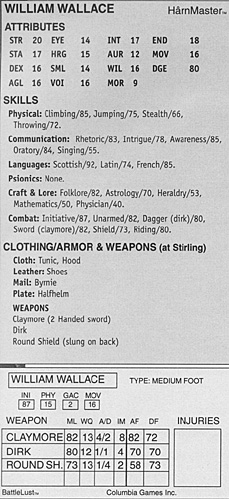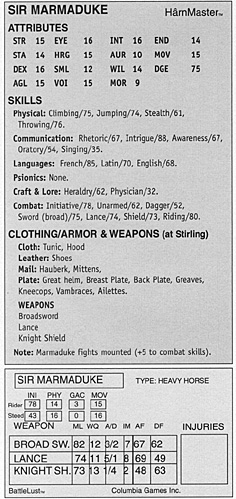INRODUCING RPG CHARACTERS
In RPGs, battles are ideal situations for PCs to get involved and possibly make a difference in their outcome. Battles are fought on many levels, and may be determined by the courage and prowess of a single warrior. In this example, the GM wants the PCs to be personally involved in attacking or defending William Wallace in individual combat. Sir Marmaduke, positioned at the head of the causeway during the slaughter, was able to see the entire battlefield. A PC role-playing his character might not choose to gallop toward the bridge as Marmaduke did historically, but instead to seek glory and crush the rebellion, by slaying William Wallace. Marmaduke, his squire, and any others he could rally might have charged Wallace's position.
When using Scotland the Brave or any wargame as part of a role-playing campaign, the game serves as a strategic level overview of the battle. The strategic level of combat involves thousands of men. Amidst all the noise and adrenaline, it would be impossible to know what was going on more than a few yards away. But through all the mayhem there is a finer degree of order to the battle: companies of men led by experienced warriors are the units to which every warrior belongs. To get to the personal level, you must go through the tactical level to identify who stands where.
The Battlelust system is best used for resolving skirmishes involving less than a hundred men. Each warrior has a roster card similar to those shown, detailing their abilities and possessions. The roster cards are inserted in 3-hole punched wallets which hold 20 cards (one company). They are arranged in the desired marching order, initiative order etc., and can be removed, replaced, or moved easily. Grease pencils or markers can be used to record wounds on the outside of the plastic wallets. These can later be wiped off, preserving the cards inside. In BattleLust tactical combat, individuals can be represented by lead or plastic miniatures, counters, or even coins. Battlelust roster cards and HarnMaster character statistics have been provided for William Wallace and Sir Marmaduke, an important English knight. Readers owning these systems can generate additional soldiers/characters to fight alongside them. In Battlelust terms, the majority of the troops are medium or light foot infantry. The Welsh archers were generally unarmored and equipped with longbows. Mounted knights were heavily armored.
Continue to use the strategic level rules until Wallace is on the line and in potential danger. At the first turn in which the Wallace unit enters combat, stop and switch to BattleLust. A Scotland the Brave counter represents 20 to 50 companies stretch over a large area (approx. 15 miles). To reduce the conflict to the skirmish level, you can select any place along the battlefront and magnify it to represent two to five companies in an area maybe 50 yards on a side where an interesting event might occur. Unless a miniature diorama is available, sketch a map area on a sheet of hex-paper noting that one hex = 5 feet. Alternatively, use a large sheet of blank paper with the scale 1 inch = 5 feet. Be sure to mark which areas are impassible. Elevation may also be a consideration. This can be represented through the use of contour lines. Set up a battlefield that makes a good adventure for your players, and causes fewer headaches for you. Be sure to take into account the maximum effective range of the spellcasters and include all intervening units in the tactical range. Note: this is your first opportunity to use magic, as Scotland the Brave does not provide rules for mages.
Battlelust units are companies of 20 men, divided into four 5-man mani (plural of manus). One man fills one hex; mani tend to stay together within Command Range of the manus leader. Warriors take damage in four Wound Levels: Minor, Serious, Grievous, and Kill. Record the damage taken by each warrior. This will be important when switching to the individual level.
If Marmaduke and Wallace become engaged directly, switch to HdrnMaster to resolve combat. In both systems, a turn is 10 seconds and turn order is determined by initiative skill. Essentially, HdrnMaster provides more detail about injuries and their effects, gives more tactical options to warriors and supports magic, religion etc.
Using HarnMaster and BattleLust together, effectively merge the tactical and man-to-man scales into one. HdrnMaster characters are compatible with Battlelust Roster cards. If either Marmaduke or Wallace have been injured, assign hit locations to the wounds and record them on the character sheets.
Resolve the combat round with HarnMaster. In the case of Wallace, and Marmaduke, Wallace would slash at his foes with his claymore. In HarnMaster terms, his action option is Melee Attack. Marmaduke's defense options include: Block, Dodge, Counterstrike and Ignore. Percentile dice are rolled against Wallace's Claymore skill and Marmaduke's Dodge (the safest option) skill. For each skill roll, there are four possible results: critical failure, marginal failure, marginal success, and critical success. If both combatants achieve the same level of success, a Miss results. When one achieves success and the other fails, the result is a Hit. Strike location is determined by a percentile roll, and injury effect is given by the table (the protection value of armor is subtracted). Some blows may be fatal or amputate a limb. Some are bleeders and others are not. Most wounds affect future skill rolls and many warriors succumb to their wounds if they are not treated. When a result happens that could affect the rest of the battle (like the death of Wallace), finish the round in HdrnMaster, then switch back to the Battlelust and conclude that battle. Take into account the effects of the Individual-scale battle on the next round (if Wallace has been killed, Scottish morale will surely falter), and continue that combat until the combat is resolved (reinforcements enter, one company retreats into a friendly space, or one side is defeated). Finally, resume the Strategic-level combat.

| 
|
Back to Shadis #49 Table of Contents
Back to Shadis List of Issues
Back to MagWeb Master List of Magazines
© Copyright 1998 by Alderac Entertainment Group
This article appears in MagWeb.com (Magazine Web) on the Internet World Wide Web.
Other military history articles and gaming articles are available at http://www.magweb.com